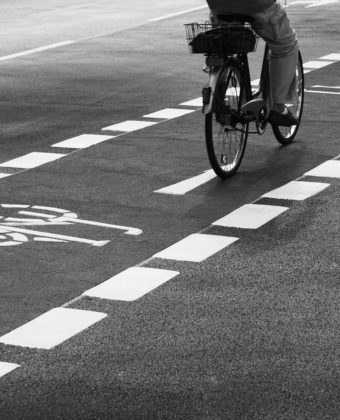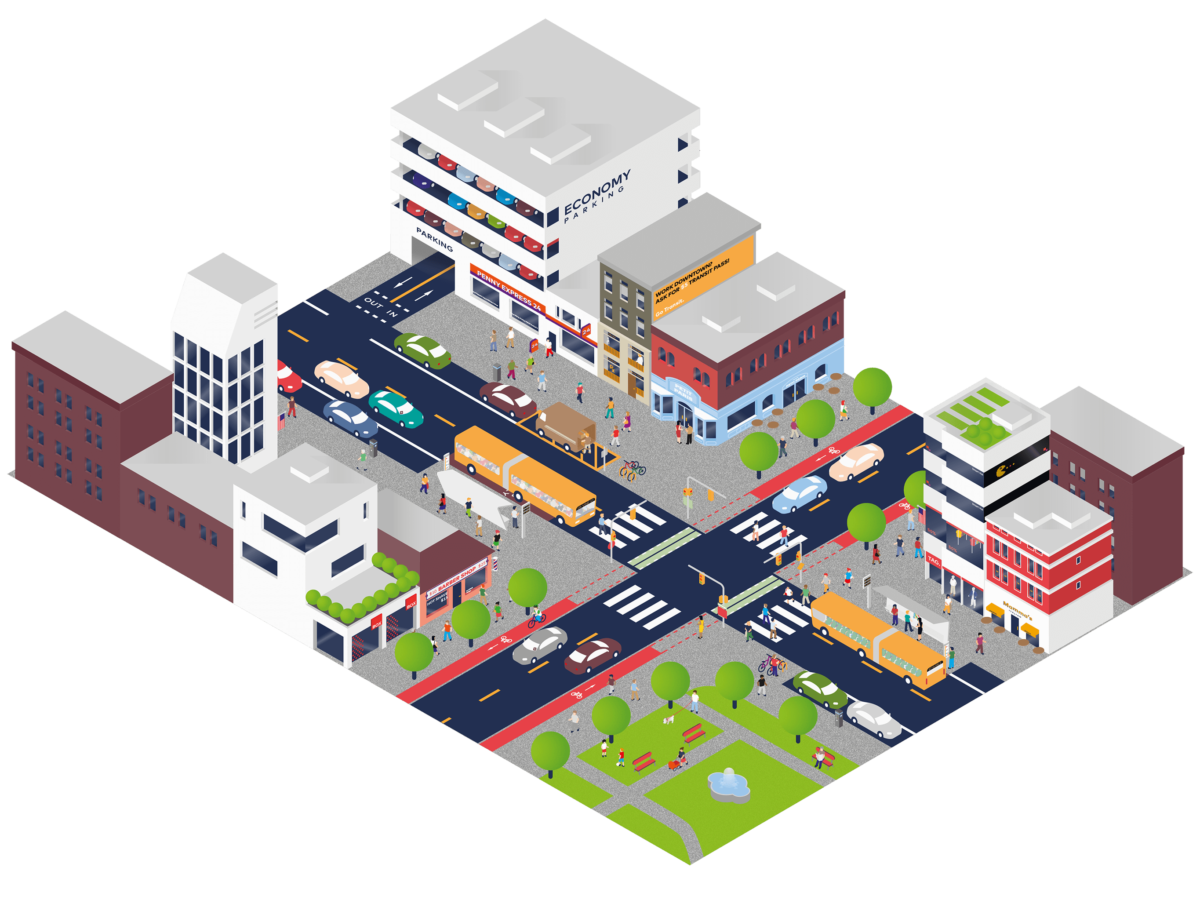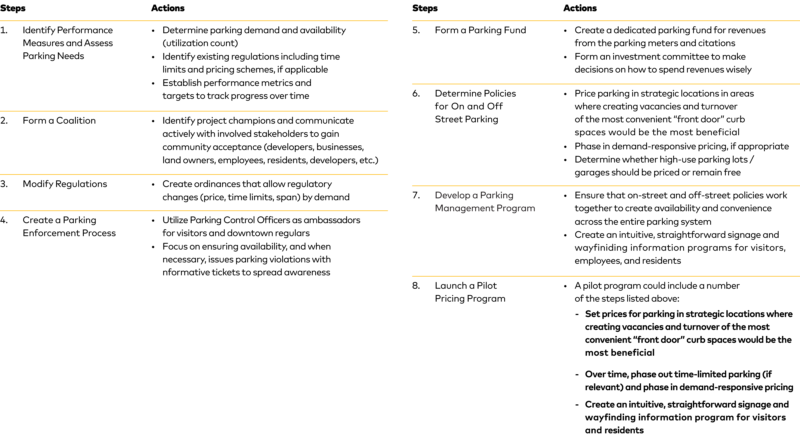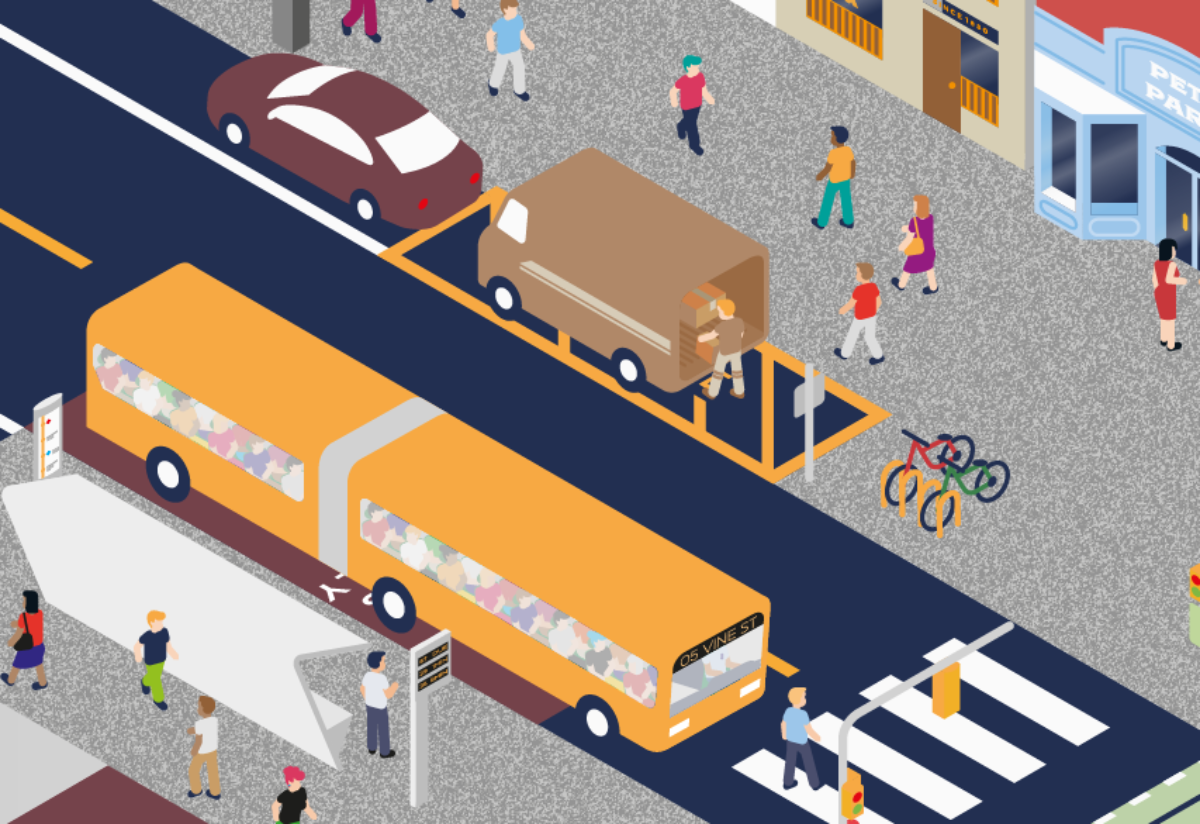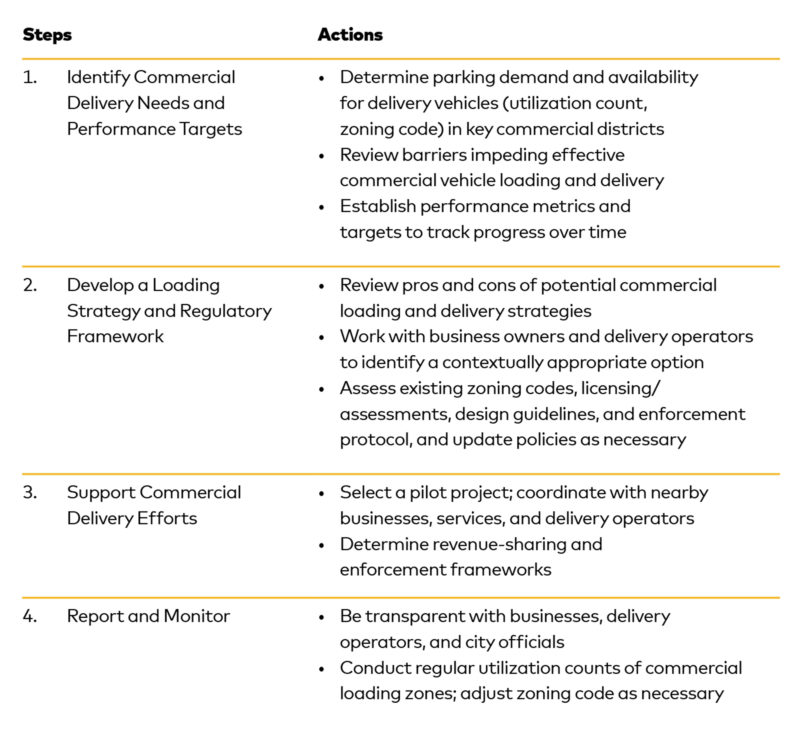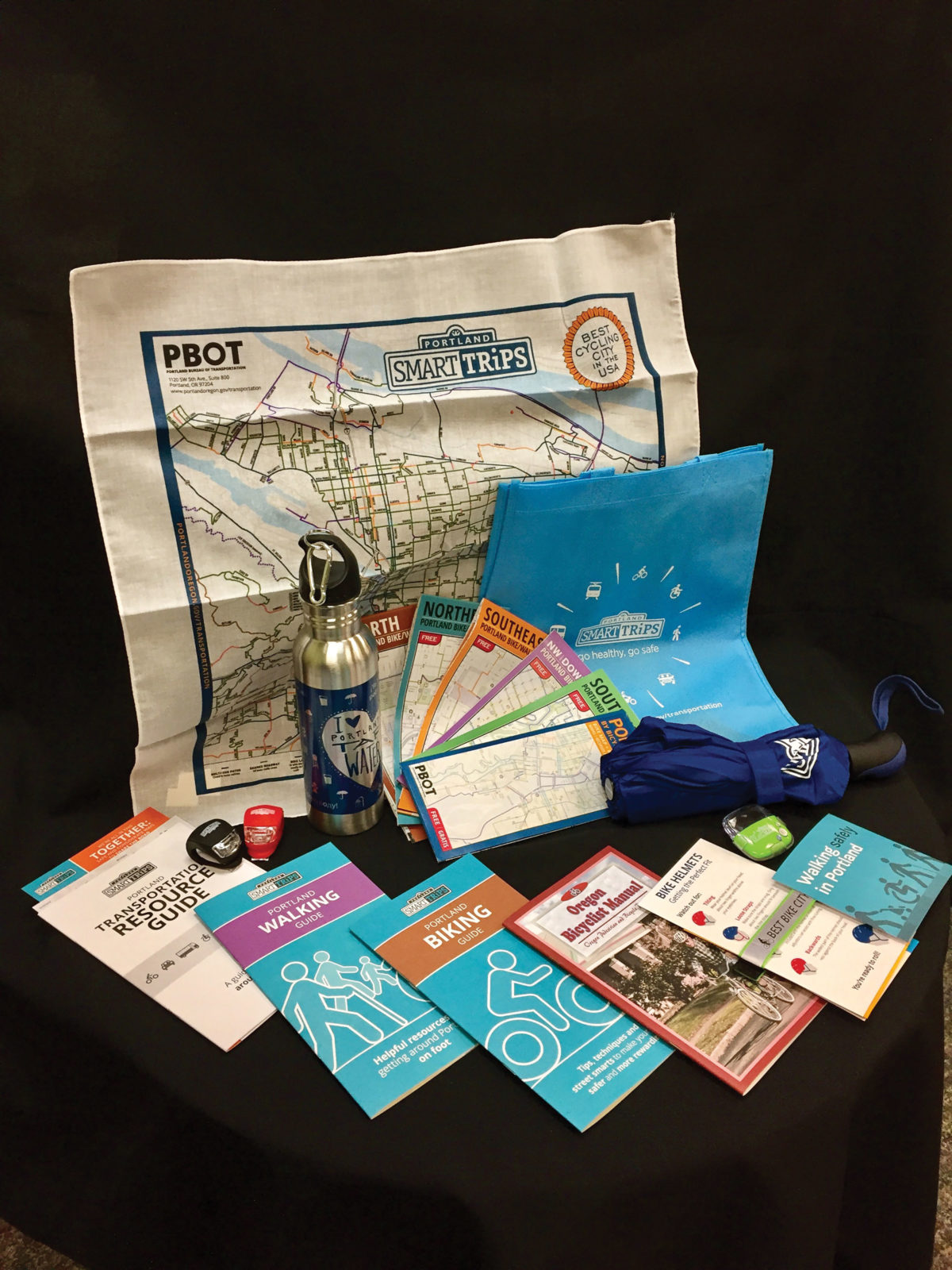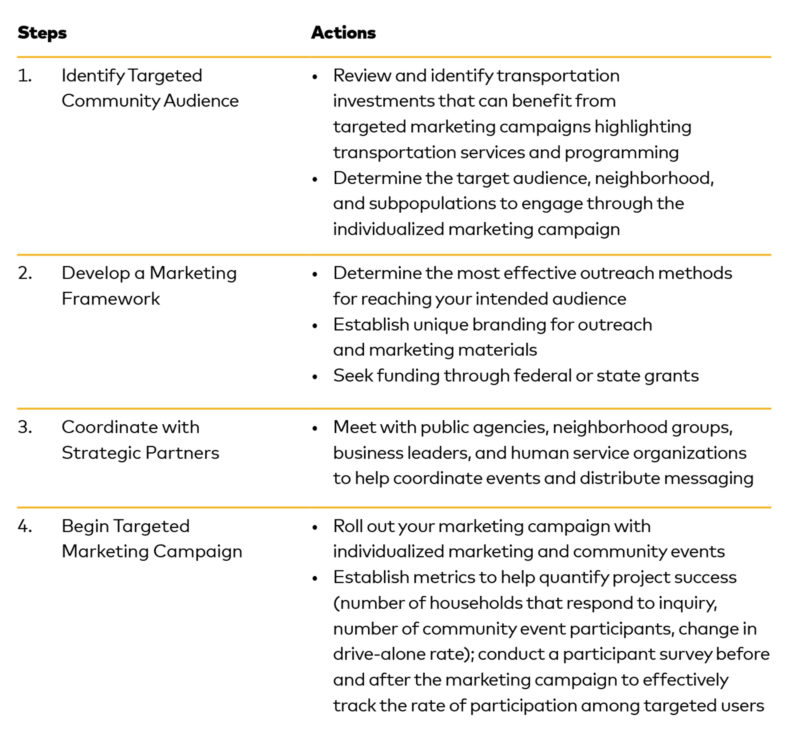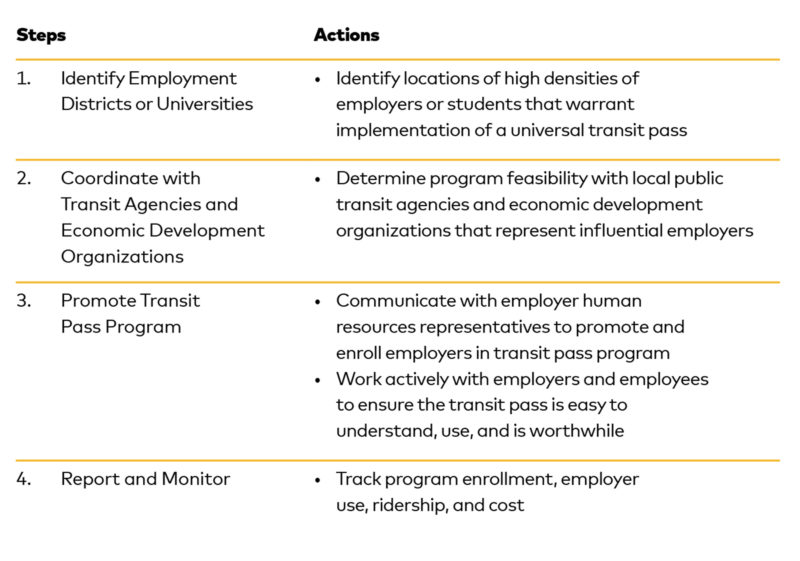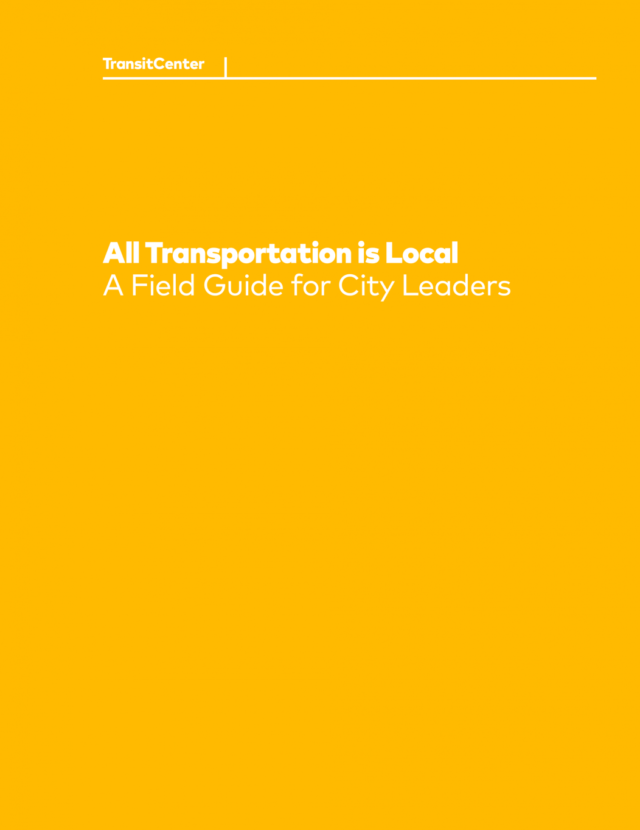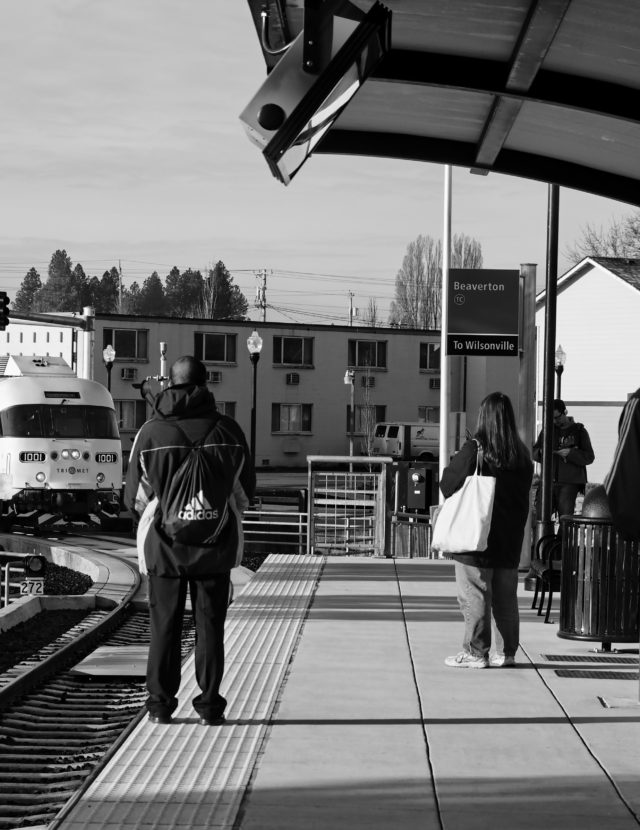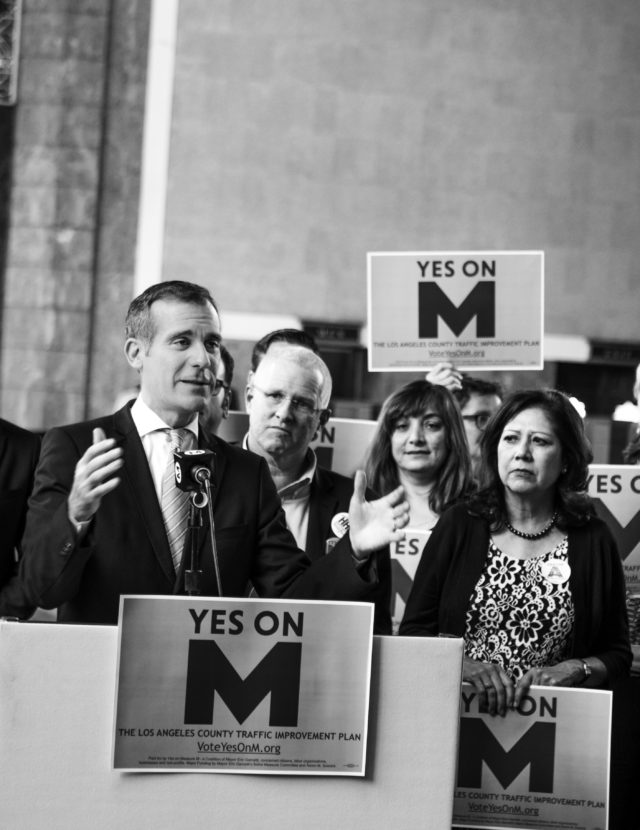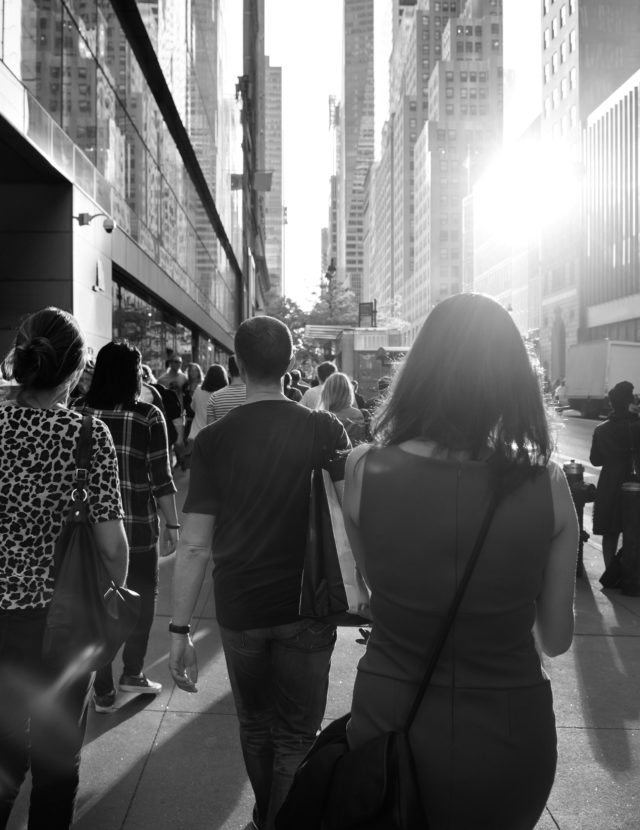Use pricing to manage parking supply
Most cities large and small have periods of the day when drivers are unable to conveniently locate parking where they want it. This leads to excess traffic as cars circle for parking spaces. Often, although visitors perceive that there is “no parking” in a busy neighborhood, there is plenty of available parking at nearby lots or side streets. Furthermore, parking may not be available because it is priced too cheaply—patrons have no motivation to leave. By instituting smart parking pricing and coordinating the management of on- and off-street spaces, cities can “buy” themselves more parking capacity, particularly during busy times and in busy locations.
Often, although visitors perceive that there is “no parking” in a busy neighborhood, there is plenty of available parking at nearby lots or side streets.
Proactively managing parking can ensure that spaces are available and utilized most effectively. Prime on-street spots should be used for shorter-term errands, like picking up a prescription. “Lower-value” spots on side streets and lots are a better fit for employees, theatergoers, and people lingering over a meal.
Parking is a key piece of the transportation system and an asset that cities must manage just as they manage other resources in their portfolios. Maintaining on-street parking provides patrons access to local businesses, freight loading and unloading locations, and convenient and accessible parking for disabled drivers. Managing parking effectively:
- Creates more vibrant places. City parking programs accommodate visitors, employees, and residents alike. A coordinated system means cities can meet their access goals and use their parking resources more effectively, and that people who still choose to drive can find appropriate parking more easily.
- Is good for business. Higher turnover on busy commercial streets means more people can access the area. Moreover, employees are encouraged to park further away from businesses, freeing up these coveted spaces for customers.
- Reduces congestion and perceptions of parking shortages. More parking spaces available to the public can reduce the need for drivers to circle the block looking for parking, resulting in less vehicular congestion on busy streets.
- Makes transit incentives more effective. When parking has a cost, programs and incentives that encourage travelers to carpool or use transit are more effective. Reductions in drive-alone travel can subsequently reduce emissions and congestion.
- Creates a new neighborhood revenue stream. Funds collected from parking meters and citations can be invested back into the community to pay for access enhancements and pedestrian infrastructure.
Cities can manage parking supply and demand by instituting demand-based pricing as a part of a coordinated approach to managing on- and off-street parking. Pricing can vary by location and/or time of day. To enable access, a good rule of thumb is to have at least one free space per block, which roughly translates to 85% of curbside spaces occupied at peak times. Above this level, research shows that the street begins to experience traffic breakdowns as people line up to park.
The San Francisco Municipal Transportation Agency sets a goal of 60%—80% of curbside spaces occupied, while Seattle aims to keep one to two spaces open per block. At these levels, parking is well used, but availability (and the perception of it) remains, so customers can find parking in the most convenient and desirable areas. Cities have used the following approaches to manage parking:
- Create a single entity responsibility for parking policy: Develop a governance structure that manages both on- and off-street parking using incentives like pricing and special parking zones and areas.
- Price parking by demand: The cost of parking should be set in a manner that allows users to pay more for the most desirable spaces until availability goals are reached. Less desirable spaces that are further away from common destinations should cost less. “Free” is a price and absolutely a component of a demand-based system. Relative to on-street spaces, off-street parking should be a bargain, encouraging users to seek it first rather than view it as a backup or last resort.
- Make adjustments gradually: The actual price of parking should be adjusted over time to avoid sudden price shocks.
- Apply time limits consistent with your access goals:Prime on-street parking should be available for short- to medium-length trips; time limits and higher pricing can achieve this objective. It may also make sense to allow commercial deliveries to be made in spaces that serve short-term parking needs. (See our “Create efficient loading spaces” sheet.)
- Consider longer (or no) time limits: Instead of time limits (which require manual enforcement), cities can rely on price to incentivize customer turnover. Prices can also be more easily changed to reflect changes in demand.
- Use smart meter/kiosk data and depoliticize individual rate changes: Instead of relying on politics, use hard data produced by parking meters to figure out whether the price of parking should increase or decrease. Change your local parking ordinance so that parking changes (price, time limits, time span) can occur automatically in response to demand, instead of requiring legislative approval.
- Make it easy to find and pay for parking: Signage and wayfinding information should be intuitive and straightforward to ensure that visitors, employees, and residents understand where they should be parking. Pay-by-phone applications reduce stress for people who have parked.
Salem, MA
Using parking-utilization data, the City of Salem determined how and where parking demand varied throughout downtown Salem. The city created multiple districts with different rates to match demand. By offering multiple rates, the city incentivized filling more spaces in its previously empty garage and created more availability on-street. Additionally, during Salem’s high tourist season (October), parking rates are modified to accommodate additional visitors and raise revenue for the city. More information is available at Parking in Salem.
Berkeley, CA
The City of Berkeley, CA coordinates their on-and off-street parking prices to both simplify information for drivers and to set rates for off-street facilities that are lower than nearby on-street rates. Berkeley uses parking zones to divide the downtown core into Premium and Value Zones, and applies demand-based pricing to on-street meters in Premium Zones to encourage turnover and increase parking availability. Demand-based pricing is also utilized in the most popular off-street parking lots and garages to encourage short-term use. For more information, go to GoBerkeley.
Huntington, NY
In 2013, the town of Huntington, NY, was underpricing on-street parking at just $0.25/hour. There was no demonstrated market for paid parking in Huntington, and thus no reliable means for determining the need for a proposed garage. After studying the sufficiency of on- and off-street capacities to meet parking demand, the town implemented a tiered pricing system——with first-time forgiveness——for on-street parking. Instead of a costly parking garage, the town invested in smart meters and shifted meter hours to create availability during the dinner-hour rush while providing free street parking during low-demand mornings.
Seattle, WA
In 2010, the city council approved criteria to allow the Seattle Department of Transportation (SDOT) to manage on-street parking with the goal of keeping each block 75%—88% occupied. The SDOT Director has the authority to adjust rates within several zones and developed a program to vary parking rates between $1 and $4 by location and by time of day. Data collected in 2011 indicated that price increases created additional parking availability.
- Parking Management: Comprehensive Implementation Guide: This 2016 report from the Victoria Transport Policy Institute outlines dozens of on-street and off-street parking management strategies.
- U.S. Parking Policies: An Overview of Management Strategies: This 2010 report from the Institute for Transportation and Development Policy highlights best practices in parking policy.
- Contemporary Approaches to Parking Pricing: A Primer: A 2012 overview of parking pricing from the Federal Highway Administration.
- Price Elasticity of On-Street Parking Demand—A Case Study from Seattle: This technical academic study derives parking price elasticities from Seattle which may be useful for transportation engineers elsewhere.
- SFpark: Pricing Parking by Demand: This 2013 ACCESS Magazine article contains more information on the SFpark dynamic pricing program.
- Turning Small Change into Big Changes: This 2003 ACCESS Magazine article summarizes on-street parking policy in Pasadena.
- Parking in Mixed-Use U.S. Districts: Oversupplied No Matter How Your Slice the Pie: This academic study finds that, across 27 mixed-use districts in the country, parking is oversupplied by 65% on average.
Create efficient loading space
To create vibrant, successful urban places and to improve quality of life and variety in commerce, cities must ensure the reliable, efficient movement of goods from the moment freight enters the city limits until it is safely delivered to its destination. Maintaining access to curbside loading zones for commercial loading, delivery, and service provisions helps support downtown business and encourages walkable, urban development.
Unfortunately, commercial loading zones are often undersized, poorly located, and/or improperly timed. Demand for loading zones is often concentrated in early morning and midday periods, outstripping available space. When zones are improperly located or sized or under-enforced, loading times are unnecessarily extended and maneuverability of delivery vehicles is limited. Time lost during the delivery process is costly to both business owners and delivery operators and can be reflected in higher prices for consumers. Failing to provide good commercial access can also lead to “truck chaos”—double-parking and other unsafe loading behaviors that worsen traffic, make the street more dangerous, and frustrate businesses.
By ensuring the availability of commercial loading spaces and reducing loading times, cities can help lower congestion on busy local streets and maintain economically viable and safe downtown cores.
- Achieve greater cost savings. Reducing time lost because of mismanaged commercial loading zones can lower costs for both business owners and delivery operators, as well as consumers.
- Efficiently manage demand. hifting some delivery demand to off-peak periods reduces peak and midday demand and makes better use of loading zones.
- Improve compliance. Targeted enforcement of delivery and loading zones can lead to higher compliance and a decrease in parking violations.
- Results in higher curb turnover. Lowering curb occupancy times for delivery vehicles will enhance curb turnover and result in greater mobility for all users.
- Reduces double-parking. More commercial loading zones available to delivery vehicles reduces double-parking and circling, resulting in improved maneuverability for all vehicles.
Many cities are beginning to apply lessons learned from recent innovations in short-term parking management to improve levels of service for curbside loading. Cities can employ several strategies and policies to establish more efficient commercial-loading protocols:
- Commercial Vehicle Loading Zone: Establish permits and charge delivery operators for access to commercial vehicle loading zones (Seattle and Philadelphia).
- Metered Loading Zones: Replace unpaid commercial parking zones with hourly, escalating metered commercial-vehicle loading spaces (New York).
- Off-Peak Scheduling: Provide cash incentives to delivery operators and customers that agree to shift delivery hours to off-peak periods (New York).
- Shared Space Design: Widen and extend sidewalks to develop pedestrian spaces that can be shared with delivery vehicles (San Francisco and Madison, WI).
- Targeted Enforcement Campaigns: Deploy a targeted enforcement program to reduce traffic congestion and improve delivery efficiency in key corridors (Los Angeles).
New York, NY
In 2000, NYC DOT initiated a pilot program called the NYC Commercial Congestion Parking Program. This program replaced unpaid commercial parking with escalating hourly metered rates for all commercial loading zones to encourage operators to vacate spaces once their loading activity was complete. By 2009, the program included approximately 8,000 curbside parking spaces, including all of Chinatown and all commercial areas in Midtown Manhattan. Program muni-meters accept coins, credit cards, and prepaid parking cards. Since implementation, curb occupancy has dropped from 140% to 95%. The typical time of occupancy has fallen from 160 minutes to 45, and just 25% of commercial vehicles remain parked for more than 60 minutes. Read more about this program in the Institute for Transportation and Development Policy’s 2010 report U.S. Parking Policies: An Overview of Management Strategies.
Seattle, WA
Seattle established a Commercial Vehicle Loading Zone (CVLZ) program in 1990 to help provide a structure and location for service-delivery vehicles to load and unload. The CVLZ is defined by yellow paint on the curb, signage, and a yellow parking meter. Companies that operate a fleet of ten or more commercial vehicles are eligible to purchase one transferable permit for every ten nontransferable permits purchased. Smaller companies must purchase a permit for each vehicle it intends to use in CVLZ locations. CVLZ permits cost $195 annually, and SDOT issues over 4,000 permits per year. Read more about this program on the Seattle Department of Transportation website.
Encourage and incentivize transportation options: Lead targeted marketing campaigns and community events
In many communities across the country, transit service is available and safe, and protected bike trails connect to key destinations. Not all residents, employees, and visitors, however, are aware of these transportation options. Outreach programs for new transportation investments, including public transit services, typically rely on mass marketing through conventional media (TV, radio, and mailings) to increase awareness. These approaches may reach a wide public audience, but mass marketing lacks personalization, and hands-on engagement can be more effective in educating some users about new transportation services and changing travel behavior. To fully capitalize on new transportation investments, city staff can partner directly with transit agencies to ensure that new services and programming are strategically marketed to the appropriate and receptive groups. Community events, such as Open Streets events (described below), are also effective ways of improving people’s willingness to try new modes.
- Generates ridership for new transit services.Individualized marketing campaigns support new public transit investments by attracting users who previously lacked access to services.
- Raises awareness. Increasing the visibility of transportation investments can create a positive public identity for them and establish a more transit- and bike-supportive culture.
- Changes travel preferences. Individualized marketing and community events help educate people who are unfamiliar with local transportation services, programming, and characteristics. Individualized marketing can increase the likelihood that residents, employees, and visitors will consider or embrace alternative transportation modes.
Targeted marketing campaigns, or individualized marketing (IM), provide tailored outreach to educate people about their travel choices. This customized information allows each marketing program to focus on the unique travel needs of the individual neighborhood, institution, or audience.
Open Streets events allow residents to try a new mode of transportation in a safe, supportive environment. Certain roads are closed to vehicle traffic, and bicyclists and pedestrians can navigate the streets car-free. In some communities, like Portland, OR, they’re referred to as Sunday Parkways, while in others, such as New York City, they are called Summer Streets.
Combined with community events, IM can effectively bridge the information gap and support a change in travel behavior—driving less and using alternative travel options more. Using a variety of outreach methods that are specifically focused on a target area or audience, IM programs are proven to have a significant impact on travel behaviors. Increasingly, IM and community events are initiated alongside major transit service and infrastructure projects to promote these investments and maximize their usage.
Several strategies can be used to effectively reach intended audiences and affect travel behavior:
- Customized Outreach: Promote transportation options within a specified geographic area and/or to a designated demographic audience. IM campaigns are typically limited in duration (about three to six months) but include significant outreach through a variety of media, such as direct mail, social media, and email.
- Unique Branding: Establishing a unique brand for individual marketing campaigns or transportation programs differentiates these initiatives from existing services. Brands can include a new name, logo, or color scheme and can be applied to transit vehicles, facilities, marketing materials, and websites.
- Community Events: Partnering with transit agencies, social service agencies, neighborhood groups, the local business community, senior centers, and health care providers to promote new transportation services can help broaden public exposure, especially among transit-reliant individuals. Community events—including mobile workshops and shared/open streets events—raise awareness of new transportation options and programming.
Portland, Oregon
The Portland region is one of the nation’s leaders in individualized marketing. The City of Portland has been leading SmartTrips (or IM) programs for years. In 2015, TriMet, the City of Milwaukie, and Metro (the regional government agency) formed a unique partnership to help launch the region’s newest MAX line—the Orange Line connecting downtown Portland to Milwaukie. An individualized marketing campaign was developed to promote the service. The target area for this IM program was approximately 4,500 households throughout Milwaukie and parts of nearby Oak Grove. Outreach included, but was not limited to, door-to-door distribution of informational materials, e-newsletters, and community events, such as a family bike ride and art walk. Survey data for the Orange Line project found that drive-alone trips among program participants fell by 10%, while walking trips increased by 50%. A similar program for the TriMet Green Line that opened in 2009 demonstrated an 18.4% reduction in drive-alone trips for program participants.1
Portland is one of the few cities that conducts individualized marketing at a scale large enough to have meaningful impact. Between 2004 and 2015, it targeted a different neighborhood each year, often sending materials to up to 30,000 households. It now focuses its program on new arrivals to Portland, using direct-mail databases to target new households with informational material.
Hillsboro, Oregon
“Drive Less Save More: Cedar Hills” was a three-month individualized marketing campaign aimed at reducing drive-alone trips. Numerous organizations, including the Oregon Department of Transportation (the primary funder), the regional government (Metro) Washington County, local jurisdictions, local businesses, and the Bicycle Transportation Alliance collaborated on this campaign.
The campaign had the specific goal of encouraging women and families to walk, take transit, bike, and carpool, and it used a neighborhood-based approach that included hand-delivering customized transportation information, hosting neighborhood events, and conducting pre- and post-program surveys.
To evaluate the effectiveness of the campaign, these pre- and post-program travel surveys measured mode share in the target area. Results indicated that residents decreased their drive-alone mode share by 1.2%, increased their transit use by 2.0%, and increased walking by 0.6%. Vehicle miles traveled were also reduced in the program target area by approximately 1,880 miles per day.
Respondents in the post-program survey were also asked if they were driving alone more often, less often, or about the same compared to six months prior—before the start of the program. About 20% of post-survey respondents stated they were driving alone less often. Of this 20%, approximately 9% claimed access to better information about transportation options contributed to this change.
1City of Portland, Bureau of Transportation, SmartTrips Green Line Final Report, 2010. For more information, visit bikeportland.org.
Long Term Evaluation of Individualized Marketing Programs for Travel Demand Management: This academic study, by Portland State University investigators, concluded that Portland-area individualized marketing programs result in behavior change that can persist for two years. The impact of these programs depends on the quality of walking, biking, and transit infrastructure in a neighborhood (better infrastructure leads to larger, more durable behavior change).
Individualized Marketing Programs (Travelchoice): In 2009, the Bay Area think tank SPUR recommended 42 different transportation policies that would help the region move more people while reducing pollution. This report excerpt recommends San Francisco adopt an individualized marketing program, and describes how such programs have been used in the Bay Area in the past.
Encourage and incentivize transportation options: Develop a universal transit pass program
In many cities, there is a lack of awareness among potential public transportation users of the transit system’s span of service, route alignments, and functionality. Moreover, in urban areas, valuable land is often occupied by parking lots and structures that cater to employees only present during weekday business hours. As more people use public transit, parking can be converted to more active, revenue-producing uses.
Universal transit passes encourage commuters to consider using public transit by reducing the cost and confusion of using the service. Universal pass programs can also help define a geographic area—e.g., a downtown—as a “transit place” and increase collaboration and cooperation among employers. Pass programs in many cities are offered for downtown employees, ensuring that a city’s largest employment base has an affordable commuting option and that limited parking spaces are available for non-employees (visitors, residents, etc.).
- Builds transit ridership. Universal transit passes increase transit ridership and help jurisdictions achieve transit mode-share goals.
- Attracts economic development. Districts accessible by transit are more attractive to new employers, require fewer dedicated parking facilities, and help promote economic development.
- Is affordable for employees and residents. Employees are more likely to use transit if the fare is free or subsidized. Universal transit passes allow people who rely most heavily on transit to use it affordably.
- Raises transit awareness. Universal transit passes broaden the awareness of transit services, especially with employees who do not actively use public transportation.
Universal transit pass programs engage employers in encouraging transit ridership and reducing congestion and parking needs associated with personal vehicles. Universal transit passes provide free or discounted transit service to employee or student users located within a given jurisdiction or campus, and they function best in areas with high employment densities, such as downtown districts. Services are typically subsidized by municipal governments, transit agencies, economic development organizations—such as development associations or business improvement districts—and/or employers.
Cities, economic development districts, and colleges can directly incentivize transit use by creating transit passes using the following models:
- District Subsidy: Employees within a designated district are provided free or reduced transit rides (Ann Arbor, MI).
- Employer-Subsidized: Employers provide subsidized transit passes to employees at significantly reduced rates (Boulder, CO).
- U-Pass: U-Pass programs are common at colleges and universities and offer reduced or free transit services to students in coordination with local transit agencies (University of Washington, Seattle, WA).1
1 “Student U-PASS,” University of Washington
Ann Arbor, MI
Ann Arbor’s Downtown Development Authority (DDA) manages nearly all public parking in the city’s downtown, with the goal of balancing parking accommodation with demand management to produce the maximum benefit to the community. The DDA uses parking revenues to sponsor a universal transit pass program, known as go!pass. The transit pass is available to all downtown employers and provides unlimited free trips on all TheRide buses. The DDA sponsors 95% of the program’s cost ($529,000 in 2015), which is administered by getDowntown. Employers are required to pay an annual participation fee based on their total number of employees; individual passes cost an additional $15, charged to the employer. In 2013—2014, go!pass ridership totaled 678,103 passengers and was utilized by nearly 500 downtown businesses.2
Read more about the go!pass program.
Boulder, CO
Boulder’s EcoPass program is an annual Regional Transportation District (RTD) transit pass available to enrolled employers. Pricing is determined by the zone an employer is located in and the total employee count. The average cost per employee is $150, and GO Boulder and Boulder Transportation Connections reimburse 50% the first year of an employer’s EcoPass contract, with a 25% reimbursement the second year. In December 2014, the EcoPass program had 107,747 participants. Full-time employees in Boulder’s Central Area General Improvement District and the Downtown Boulder Business Improvement District are eligible for the Downtown Employee EcoPass; employees ride free on all RTD services with no charge to the employer. Read more about Boulder’s EcoPass.
2Ryan Stanton, “Use of go!passes by downtown Ann Arbor workers grows 7% in last year,” MLive, April 10, 2015.
Take the lead on Uber, taxis, and emerging mobility providers
With the rise of emerging mobility providers like transportation network companies, on-demand transit, and carsharing systems, cities are facing a changing transportation landscape. While these services offer the potential to provide more choices for citizens, they also can prove confusing to policymakers. Some principles to keep in mind:
These days, cities are bombarded by claims that driverless cars and transportation network companies make fixed-route transit unnecessary. These claims, often peddled by self-interested technology leaders or anti-transit activists, fail to grapple with geometry. Technology and venture capital can’t change the fact that 40 people in 40 cars take up more space than 40 people on a single bus. Transit——capable of moving up to 8,000 people per hour in a dedicated transit lane and up to 25,000 in a dedicated transitway——will always be the most space-efficient way of moving people. Private cars might carry up to 1,600 people per hour on an urban street. Even if driverless cars can travel closer together, it is difficult to imagine them outperforming transit in dense neighborhoods.
In major cities, e-hail companies have a competitive advantage at night and during other times when few people are traveling but cannot match the capacity of public transportation during peak travel hours. Recent research also calls into question transportation network companies’ overall financial viability—Uber in particular.
Taxi and for-hire vehicle policy is often viewed as a consumer-protection and licensing issue and is isolated from the departments and agencies that govern streets and transit.
The rapid emergence of ridehailing and microtransit companies, however, raises new issues, and cities need to be prepared to regulate and set incentives in new ways to respond to emerging challenges.
Accessibility, equity, safety, sustainability——and to support new transportation modes in accordance with their ability to support the public interest. If a city wishes to reduce per-passenger pollution or reduce the number of vehicles on the road, for example, that city ought to create financial incentives and/or regulatory mandates that promote high-occupancy vehicle use. This basic notion of incentivizing cities’ strategic goals in line with the public interest applies equally to e-hail providers, taxis, personal vehicles, buses, trains, and (someday) autonomous vehicles. Some technology-specific questions are valid, but most are a distraction from core, fundamental issues like parking policy, street space allocation, and for-hire vehicle regulation.
For example, the San Francisco Municipal Transportation Authority views e-hail and shuttle services as worth encouraging (and setting aside street and curb space for) because they reduce reliance on private automobiles. Bay Area Rapid Transit dedicates space for carsharing services at some of its rail stations, but only if the carshare space is predicted to generate more transit trips than a normal parking space. Similarly, it may be reasonable for cities and transit agencies to subsidize e-hail service or on-demand transit in areas currently served by marginal bus routes, if that bus service is redeployed to add frequency in places with high ridership.
Cities have assets that can benefit emerging mobility companies, like street and curb space. These should be used as leverage to achieve policy goals. For example, Seattle allows a carshare company to park its vehicles freely within the city but requires that the service cover the entire city so that the benefit is not restricted to wealthier neighborhoods.
San Francisco Municipal Transportation Authority 2013—2018 Strategic Plan: Goal 2 of the agency’s strategic plan describes its approach to taxis and ride-hailing.
A San Francisco non-profit, Livable City, partnered with Lyft to designate loading zones for ride share vehicles at the San Francisco regional commuter rail (CalTrain) station to promote the connection between ride sharing and transit.
Centennial, CO: Centennial partnered with the Denver South Transportation Management Association on a pilot program to subsidize passengers who use Lyft Line to reach the Denver Regional Transportation District’s Dry Creek Light Rail Station weekdays between 5:30am and 7pm. Pilot projects like this should be designed to help cities learn how to address their most pressing transportation challenges in new and creative ways.
The Los Angeles Department of Transportation hired a transportation technology research fellow to inform the agency’s
short-, medium-, and long-term technology strategies—from building a solid data foundation to preparing for an automated future.
This policy area is moving quickly. The examples listed above are not necessarily best practices, but examples of how cities are experimenting with emerging mobility providers to achieve transportation goals.
Ride-Hailing Services: Opportunities and Challenges for Cities: This white paper from the National Association of City Transportation Officials is a useful primer for cities that want to change how they regulate e-hail services like Lyft and Uber. It outlines positive and negative outcomes that may result from increased e-hail service, the questions cities should ask to understand how their regulations may need to change, and key considerations that often arise when seeking to regulate e-hail services (such as safety, data, economic competition, accessibility, and connections with other modes).
Private Mobility, Public Interest: This TransitCenter report identifies actionable short-term opportunities for transit agencies and municipalities to work with emerging mobility providers. More than a dozen project-specific case studies highlight opportunities to reinforce transit’s strengths, plan more flexibly and with users in mind, and leverage valuable agency infrastructure and financial resources. This report is built on a foundation of more than 100 interviews with industry representatives from the public and private sectors.
Why Uber Won’t Kill Transit: This TransitCenter fact sheet lays out key arguments for advocates and city leaders contending with claims that new technology makes transit irrelevant. It points out that e-hail cannot physically replace high-frequency bus and rail and is actually less effective at moving people than low-ridership bus routes. It points out that peak demand for transit and e-hail services occurs at different times of the day.
Shared Mobility and the Transformation of Public Transit: This report provides recommended actions that public entities—transit agencies, transportation departments, and other local and regional agencies—can take to promote useful cooperation between public and private mobility providers.
